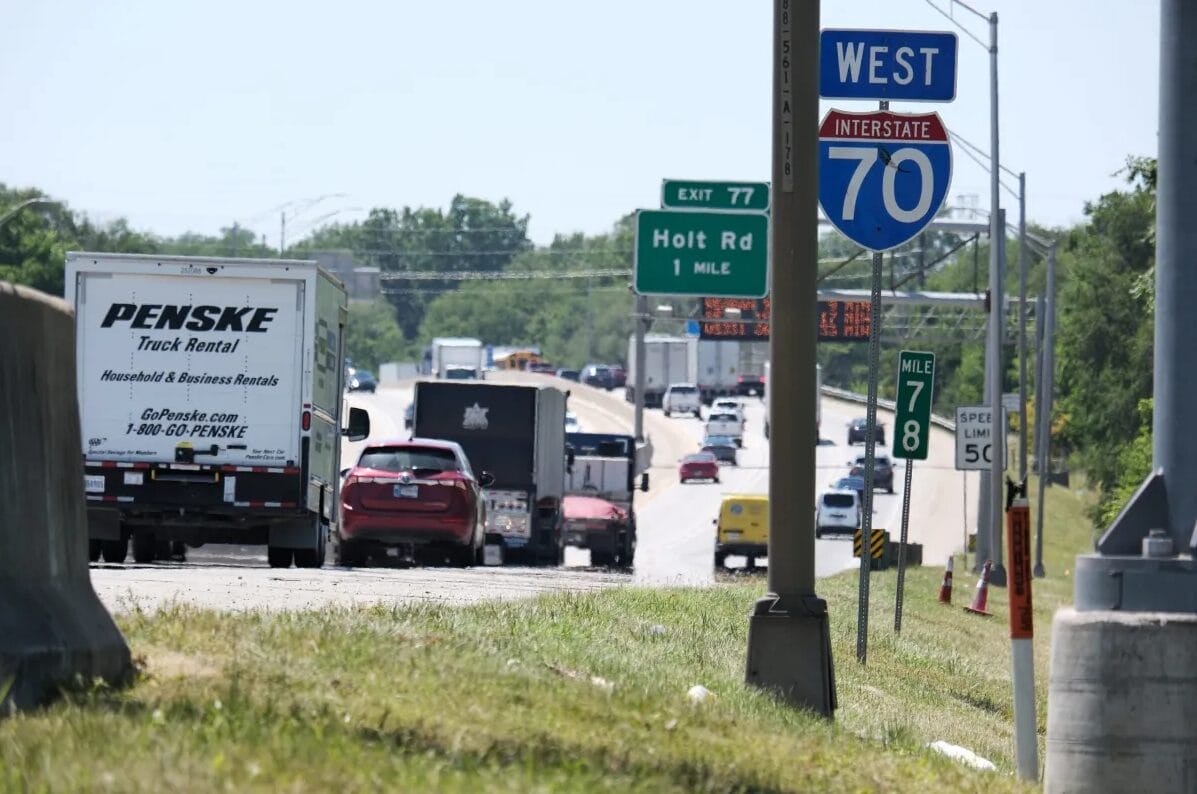How would you change I-65 and I-70 in Indy?
(MIRROR INDY) — The roar is loud and constant at Candace Miller’s home on West McCarty Street. Living about 100 feet from Interstate 70’s westbound lane means she’s been able to hear every vehicle every day for the past two and a half years.
She’s gotten used to the din. Now the only time she worries about the interstate is when other sounds pierce the roar, such as crashes or sirens — or the rattle of a stranger trying to open her neighbor’s door. Sometimes, she says, they happen all at once.

“We’ve had cars come off the road after they get in wrecks,” she said. “Then people jump the fence and try to get into peoples homes to not get caught by the police.”
Families living in dozens of West Indianapolis homes on McCarty Street, Wyoming Street and others that run parallel to the interstate are only separated from it by an embankment, a few sparse trees and a waist-high chain link fence.

Miller said she’d like some sound barriers to reduce the noise, but she said the state should prioritize things that could protect her home, such as more lighting on the interstate and more protective fencing on the embankments.
“If it’s raining and it’s dark, you can’t see anything,” she said. “I feel they should spend some money and make sure people that are driving can see better.”
Miller’s concerns are the types of comments the Indiana Department of Transportation wants to hear from Indianapolis residents as it considers the future of the inner loop, made up of I-70 and Interstate 65.
Both interstate routes were built in the 1970s and are nearing the end of their service lives. INDOT plans to modernize them, but it first wants to hear how residents think it should approach the upgrades.
The agency is taking public comments through its Pro Planning and Environment Linkages program, or ProPEL Indy, until June 30 and will have several public information sessions around the city.
Original project split neighborhoods
When the Indianapolis portions of I-65 and I-70 were originally built, the interstates split neighborhoods, such as West Indianapolis, in the path of the selected inner loop routes. About 8,000 buildings were demolished for the projects, displacing about 17,000 residents, according to the Oct. 15, 1976, edition of the Indianapolis Star.
Little consideration was given to how the projects would affect those neighborhoods. The projects were designed in the 1960s and predated the 1970 National Environmental Policy Act, which requires environmental impact assessments for major federal actions. That includes how a proposed project would affect the people living near it.
Many residents at the time were unhappy with the project. Some would form groups like the West Indianapolis Neighborhood Congress that would scrutinize future transportation projects and would oppose the projects when they didn’t serve the interests of the community they represented. The group and other city residents successfully opposed the construction of a proposed Harding Street freeway that would have linked I-65 in the north to I-465 in the south through I-70.
Building projects around residents’ needs

ProPEL Indy project manager Tim Miller said future interstate projects will be planned with the needs of the public, businesses, and other organizations in mind instead of imposing the projects’ needs on them.
“What we’re trying to ask people to do is re-imagine how those interstates function within our community, whether that’s from a mobility standpoint, safety standpoint, or efficiency standpoint,” Miller said. “Instead of just giving ideas about this — saying this is how it will be — let’s have a conversation about how we want (interstates) to function in our community.”
The feedback that state officials receive from the public will be used to create plans for the interstate sometime next year. At that point, they’ll ask for more input.
“This is a generational study,” Miller said. “It’s very important that people get engaged.”

Residents like Miller expressed concerns that the outreach was just a formality before the state builds newer and bigger versions of the existing interstate, like the North Split project connecting I-65 and I-70 in the northeast part of the inner loop.
“They’ll act like, ‘We’ll take your comments,’ just to say it and pretend like they’re trying to have your back, but in my experience nothing’s ever done with that feedback,” Miller said.
But others are optimistic about the prospects of changing the interstate system for the better.
“I’m very impressed with their outreach. I think that they’re taking it seriously,” said Jakob Morales, who works on the west side. “These are projects that are going to be around for a very long time and affect millions of people. This is the future, so it’s important to them.”
Morales said he wants INDOT to completely reimagine the interstate system.
“(They should consider) highway elimination and transforming them into slower boulevards that are dense, transit oriented and that aren’t going to leave us with these polluting interstates for the next 50 years,” he said.
What do you think?
ProPEL Indy will hold several more information sessions this month and will accept public comments online until June 30.
Tuesday, June 18
Martin University
2186 N. Sherman Dr.
3-5 p.m.
Wednesday, June 26
Guion Creek Middle School
4401 W. 52nd St.
4-6 p.m.
For more information, head to the ProPEL Indy website.

